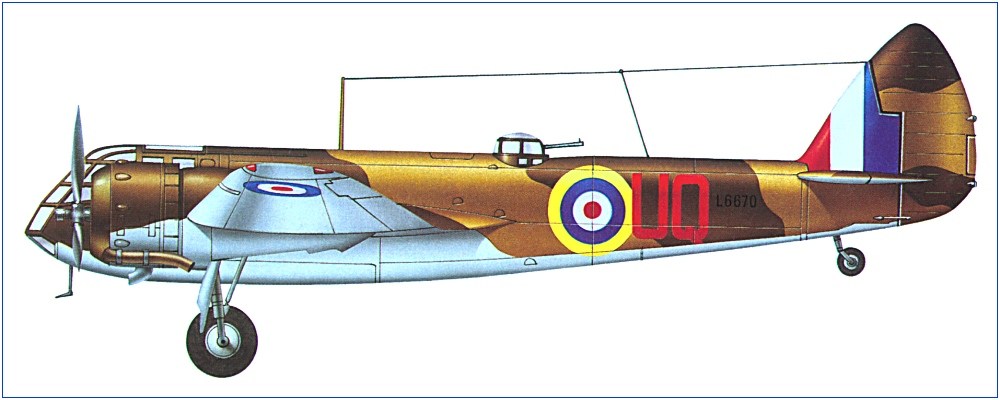Bristol Blenheim

Blenheim Mk I
|
|
|
|
|
|
|
Light Bomber (Mk IV) |
|
|
|
|
|
3 |
|
|
|
|
|
two 920hp Bristol Mercury XV radial engines |
|
|
|
|
|
Max speed |
428km/h (266mph) at 3,595m (11,800ft) |
|
Service Ceiling |
6,705m (22,000ft) |
|
Max Range |
2,340km (1,460 miles) |
|
|
|
|
Span |
17.7m (56’ 4’’) |
|
Length |
12.98m (42’ 7’’) |
|
Height |
2.99m (9’ 10’’) |
|
Weight |
6,537kg (14,400lb) loaded |
|
|
|
|
one 7.7mm (0.303in) Browning machine gun in leading edge of port wing, two 7.7mm (0.303in) Browning machine guns in dorsal turret, two 7.7mm (0.303in) rearward-firing blister position under nose; max internal bomb load of 454kg (1,000lb) |
|
|
|
|
|
- |
|
In August 1935 the Air Ministry issued Specification B28/35, covering the conversion of the Bristol Type 142, a fast eight-seat passenger aircraft developed as a private venture, to the bomber role under the designation Type 142M. This meant major modifications to accommodate a bomb bay and an observer/bomb aimer in the cockpit. The wings were raised from a low-level to mid-level position and the nose widened.
In creating this variant the thinking was it could outrun any fighter of the day and so it was fitted with light defensive weaponry only; a single Lewis 7.7mm (0.303in) machine gun in a dorsal turret and one fixed-position Browning 7.7mm (0.303in) in the port wing.
In September 1935 the Air Ministry placed an initial order for 150 aircraft designated Blenheim Mk I. Trials were successfully completed in December 1936 and a second order for 434 aircraft was placed.


114 Squadron received the first Blenheims in March 1937 and at the outbreak of the Second World War in September 1939 the RAF had received 1007. 147 of these were completed as fighter variants and designated Mk IF, fitted with a ventral gun pack containing four Browning machine guns; some of these later served as interim night-fighters during the Battle of Britain and were fitted with AI radar. In total 1,280 Blenheim Mk I and MK IF’s were built.
By the time war broke out most of the Blenheims were serving in the Far and Middle-east with those based at home were upgraded to MK IV specification. The Mk IV was basically the Mk I with two 995hp Mercury XV radial engines driving de Havilland three-blade variable pitch propellers, extra fuel capacity and a lengthened nose.
Blenheims carried out the RAF’s first offensive operation on the 2nd day of the war; aircraft of Nos 107 and 110 Sqns from Marham, Norfolk unsuccessfully attacked units of the German Navy in the Elbe estuary. Subsequent battles for Norway and France highlighted the vulnerability of the Blenheim when they suffered appalling loses. The armament was increased to five machine guns and attacks continued on targets in France and Holland and anti-shipping patrols in the English Channel. 1,930 Mk IV’s were built before being replaced by the Douglas Boston and the de Havilland Mosquito. The final British built version was the Mk V of which 942 were built, most of these were modified for tropical climates, designated Mk VD and served in the North Africa campaigns, unfortunately suffering very heavy losses there also. They were soon replaced with US Baltimores and Venturas.
Blenheims were built outside of Britain by Fairchild of Canada for the RCAF and designated Bolingbroke Mk’s I to IV. Finland built an additional 55 and another 48 were built under licence in Yugoslavia.
 Royal Air Force
Royal Air Force